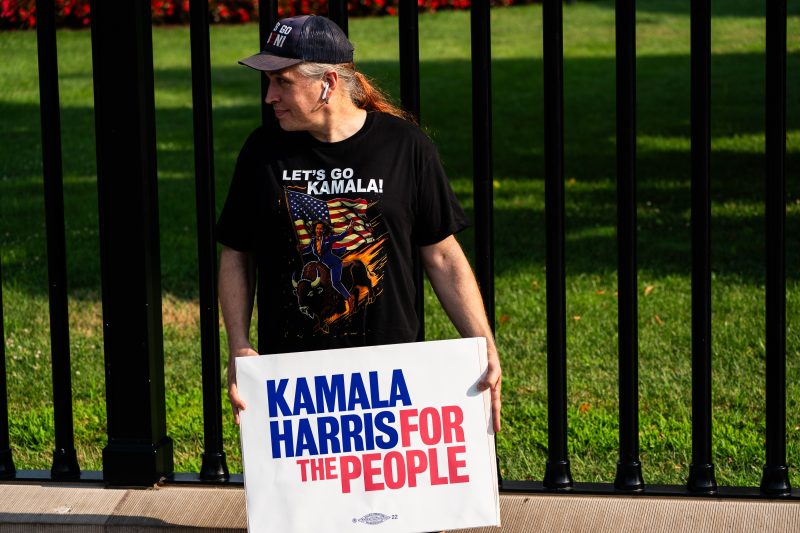About 24 hours after President Biden’s historic announcement that he’s ending his 2024 campaign, Democrats appear to be largely united behind replacing him with Vice President Harris.
Virtually every major would-be rival for the nomination is now backing her, as are more than 70 percent of congressional Democrats. Some state Democratic parties are already moving to commit their delegates to her.
It’s been a remarkable closing of ranks — especially when you consider there is scant hard evidence that Democrats are much better off with Harris than with Biden.
A Washington Post review of polls conducted after Biden’s stumbling June 27 debate performance shows Harris trailing Donald Trump by 1.5 points, while Biden trailed by 1.9 points. Harris performs similarly to Biden in the few swing-state polls that have tested her, and disapproval of her outpaces approval by double digits in most polls.
You could be forgiven for thinking that Democrats are just ready to be done with all this — that they’re bowing to the reality that bypassing Harris would be too difficult, and that they’re being somewhat Pollyannaish about a flawed candidate’s prospects.
But there’s certainly a possibility that Harris taking the reins and reintroducing herself could recast the race. Virtually every poll we have on this has been in the realm of the hypothetical, and now it’s reality.
Here’s what we can say about where things stand, and where they go from here.
Her image is poor but has more upside
The first thing to note is that vice presidents’ images are often tied to the presidents they serve. When the president declines, they decline too. It’s likely that many voters haven’t truly consumed much information about Harris; now they will.
She certainly starts at a familiar, if somewhat less stark image deficit. Her disapproval rating is about 12 points higher than her approval rating in the FiveThirtyEight average, while Biden is more than 17 points underwater.
But significantly, fewer voters are dug in against her. While Biden’s average disapproval is 56 percent, hers is about 50 percent. Generally, fewer than 4 in 10 voters have strongly negative feelings about her.
That suggests she could have a higher ceiling in this race, if she takes advantage of it.
If she can’t improve that 12-point image deficit, though, it will be a problem. While Americans view Trump unfavorably by 12 points, that’s more a measure of the person than the job performance. And retrospective approval of Trump’s presidency is often slightly better than his personal image.
There’s an opening for a more standard-issue Democrat
Perhaps the most optimistic data points for Harris involve the way other Democrats (not named Biden) have been performing.
While Harris and Biden have trailed nationally by between one and two points, Democrats currently hold a small lead on the generic ballot — meaning when voters are asked to choose between an unspecified Democrat and an unspecified Republican for Congress.
Also key on this front: In the vast majority of Senate races, the Democratic candidates have performed better than Biden — and often significantly better:
A Washington Post review of recent Senate polling shows the Democratic candidate beating Biden’s margins in 17 of 20 Senate races. The only exceptions were in uncompetitive races in Maryland, North Dakota and West Virginia.
The average Democrat performed more than five points better than Biden, on the margins. And in 8 of the 20 races, the Democrat’s margin has been as much as double digits better than Biden’s.
Some of these are Democratic incumbents who tend to have stronger brands. And often, it’s about Republicans taking less of the vote than Trump. But Democrats have also done better than Biden in many open-seat races and even in races with GOP incumbents (as in Florida, Missouri, Tennessee and Texas).
These data could certainly be read to suggest that a candidate who can successfully pitch themselves as a more standard-issue, acceptable Democrat — without Biden’s age and mental acuity concerns — could be better positioned.
“I don’t think Joe Biden has a ton of advantages,” top Trump campaign adviser Susie Wiles told the Atlantic’s Tim Alberta back in March, as Alberta reported this week. “But I do think Democrats do.”
A big question is whether she can pull back young and diverse groups
Democrats’ big problems with Biden on the ticket haven’t just been his age; more specifically, they’ve been his apparent erosion in support with key Democratic-leaning groups — especially young, Black and Hispanic voters. His numbers with those groups have been worse than those for virtually every recent Democratic presidential nominee.
There is some evidence Harris could help on that front.
A Washington Post/ABC News/Ipsos poll earlier this month showed her running four points higher than Biden with Black voters and Hispanic voters, and five points higher with voters under 40.
That’s only a modest improvement on Biden, and the 14 percent of Black voters and 42 percent of Hispanic voters she was ceding to Trump would still be some of the highest GOP numbers in decades. But the data suggests she could make inroads in ways Biden hasn’t been.
In addition, 22 percent of Black voters who didn’t back Harris against Trump said they would consider her, as did 12 percent of Hispanic voters. She also showed more upside with young voters; in addition to her higher level of support, 14 percent of those who didn’t back her said they would consider her — compared to 10 percent for Biden.
Combine those numbers with the voters already supporting Harris over Trump, and nearly 9 in 10 Black voters said they would at least consider voting for Harris, as did about 6 in 10 Hispanic voters and voters under 40 years old. Those numbers are higher than Biden’s in each case, indicating Harris has a higher ceiling.
So the opportunity is there for her to improve Democrats’ standing. The main question is whether Harris is capable of seizing on it.

